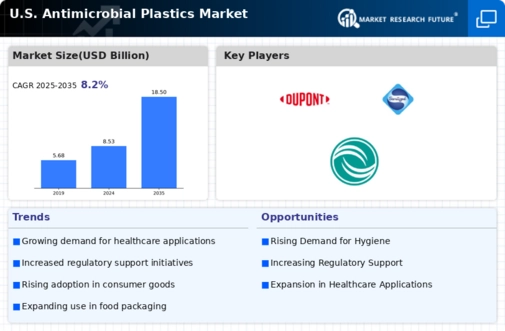Market Share
US Antimicrobial Plastics Market Share Analysis
In the highly competitive landscape of the US Antimicrobial Plastics Market, companies strategically deploy various market share positioning strategies to establish a robust presence and gain a competitive edge. A fundamental strategy involves a relentless focus on product innovation and efficacy. Antimicrobial plastics producers invest in research and development to enhance the antimicrobial properties of their materials, ensuring effective protection against bacteria, viruses, and other pathogens. By offering high-performance antimicrobial plastics, companies aim to position themselves as leaders in the market, catering to industries such as healthcare, packaging, and consumer goods that prioritize hygiene and infection control.
Cost leadership is another pivotal strategy embraced by companies in the US Antimicrobial Plastics Market. This approach revolves around optimizing manufacturing processes, negotiating favorable supplier contracts, and achieving economies of scale. Becoming a low-cost producer enables companies to offer competitive pricing for their antimicrobial plastics, attracting a broader customer base. Cost-effective solutions not only appeal to price-conscious consumers but also provide companies with a strategic advantage against pricing pressures and market fluctuations, ensuring sustained profitability.
Market segmentation plays a crucial role in the positioning strategies of antimicrobial plastics manufacturers in the United States. Recognizing the diverse applications of antimicrobial plastics in various industries, companies tailor their products to address specific market segments. This may involve producing antimicrobial plastics with specific characteristics for use in healthcare settings, food packaging, or consumer goods. Effective segmentation enables companies to optimize their market share within specialized niches, providing solutions that precisely meet the needs of different industries and applications.
Strategic collaborations and partnerships are instrumental in enhancing market share positioning within the US Antimicrobial Plastics Market. Companies often form alliances with healthcare institutions, packaging manufacturers, and consumer goods companies to strengthen their supply chain, expand market reach, and facilitate innovation. Collaborations can lead to joint research projects, shared resources, and the development of application-specific antimicrobial plastic solutions. Partnering with key stakeholders allows companies to leverage collective strengths, share expertise, and collectively address the complexities of the antimicrobial plastics industry more effectively, contributing to increased market share.
Sustainability is emerging as an increasingly important factor influencing market share positioning strategies in the US Antimicrobial Plastics Market. With a growing emphasis on environmentally friendly practices, companies are incorporating sustainable materials into their antimicrobial plastics, optimizing energy consumption, and exploring eco-friendly sourcing alternatives. Antimicrobial plastic manufacturers positioning themselves as environmentally responsible entities can gain favor among customers who prioritize sustainable and responsibly sourced materials, contributing to the overall sustainability of the industry.
Moreover, a robust digital presence is crucial in today's technologically driven business environment. Antimicrobial plastics companies in the United States leverage digital marketing, online platforms, and e-commerce channels to connect with customers, showcase their expertise, and facilitate business transactions. An effective online presence enables companies to reach a broader audience, provide educational resources, and engage with clients directly, enhancing brand visibility and trust in the competitive antimicrobial plastics market.

















Leave a Comment